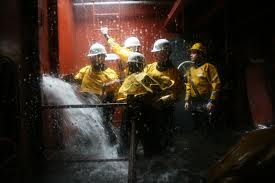

Ship Flooding Emergency Procedures is a very important part of a ships emergency literature. It is available at all areas of the ship from the deck to the engine room, it is there everywhere. This is to ensure that all the crew members in the ship know their roles and what is expected out of them when they are on duty.
This ensures that in times of emergency the least number of causalities happen. A ship floats in sea water so it is quite possible that the sea water enters the ship and causes damage to it. When the ship is flooded with sea water it might drown and cause a lot of loss of life and property. When there is a sudden flow of water into a ship then it is quite important that the source of the flow of this water is ceased.
The Ship Flooding Emergency Procedures clearly states that when is it that the ship might get flooded with water. Well the reasons can be many. The first one is collision. When to ships collide then the hull of the ship might get damaged as a result it can let water gush in. Nowadays the water tight bulk heads are used right up to the level of the main deck. This ensures that overflowing of water does not happen easily. In the olden days this was a very important reason for many ship accidents. The crude oil tankers have hulls that are double skinned this ensures that very little or no oil leaks out in case of collision. This ensures less pollution too.
We all know about the famous Titanic that drowned after it collided with an ice berg. Collision with ice bergs can also lead to huge damage to the hull of the ship and lead to flooding eventually. The modern hulls as already explained above are designed in such a way that they will not let any water get in easily. However, the experts belive that regular check must be done by the watch keepers. The gauges cannot be relied on completely as by the time they show signs the damage must have been done already. Another very common reason for flooding of a ship is hurricane or storms that we have no control on.
The best way to avoid this situation is to batten down the hatches. Changing the course to avoid the storm can also be a good idea. Reducing the engine speed can also avoid flooding and sinking. In the past many ships have been lost to storms and hurricanes as we have no control over the forces of nature. However, these points that are mentioned in the Ship Flooding Emergency Procedures can definitely be of great help.
The Ship Flooding Emergency Procedures also states some more things that can be done in a bad weather. First compile the reports and inform the technical team who are trained to look into these situations, secondly closely monitor the weather conditions, practice damage control so that you can reduce damage to the crew and the vessel, you can also look at jettison of cargo to save the vessel, the last method is to use ballasts/deballast method to get the ship back on track.
The emergency and damage control team is a must in all the ships. They ensure that the crew members are safe in times of emergency and they help the crew members to work as a team at times of such crisis. They basically ensure that the ship operates fine even under situation of emergency. They also have a support team the gives first aids and prepare life boats.
If the engine room is flooded then the bilges must be controlled to ensure that the sea water does not enter the main power generators. The Ship Flooding Emergency Procedures also states that the bilge suctions should be opened and bilge pumps activated. If the water enters the main power room the situation will go out of control as the loss of main power and main engine will happen. It gives a detailed guide on how the bilge should be operated.
The most important factor is that the crew members must keep calm and work as a team. Ship Flooding Emergency Procedures are indeed a good source of information to survive a flooding ship.
Ship Flooding Emergency Procedures,




